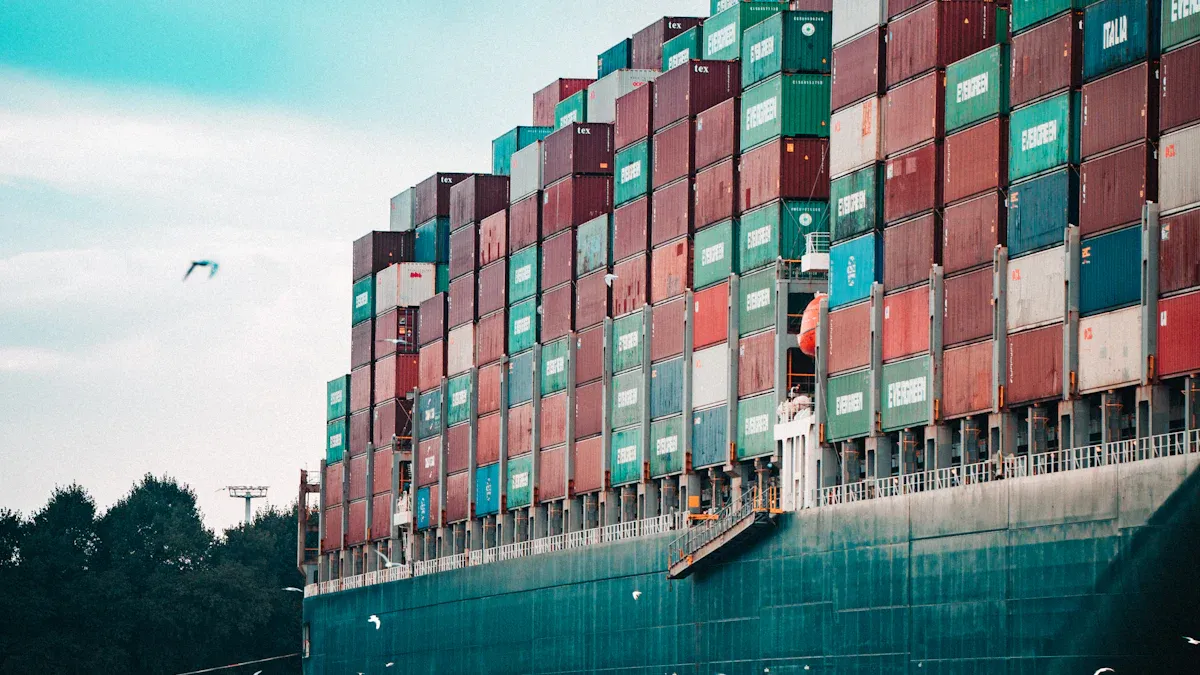Automotive Supply Chain Scramble: Navigating Trump’s Tariff Tempest

Trump’s tariff policies have created a turbulent environment for the automotive supply chain, disrupting established trade flows and increasing operational costs. Vehicles built in Canada or Mexico, such as GM’s full-size pick-up trucks and the Toyota RAV4, face significant risks due to tariff exposure. Meanwhile, 71% of industry professionals identify rising tariffs as the most pressing supply chain issue, with 80% predicting the automotive sector will bear the brunt of these changes. Businesses must act swiftly to mitigate these challenges, as new vehicle prices could rise by up to $6,000, further straining consumer demand.
Trump’s Tariff Policies and Their Impact on the Automotive Supply Chain

Scope and Implementation of Reciprocal Tariffs
Trump’s reciprocal tariffs aim to match the import duties imposed by trading partners on American goods. This policy introduces a complex framework for calculating tariffs, as it may involve national-level tax rates or product-specific duties. For example, the United States could raise tariffs on European vehicles from 2.5% to 10% to align with the European Union’s rates. The inclusion of non-tariff barriers, such as value-added taxes and subsidies, further complicates the implementation process. This ambiguity creates significant challenges for businesses in the automotive supply chain, as they struggle to predict and adapt to these changes.
Key Challenges for Global Automotive Trade
The global automotive trade faces unprecedented uncertainty due to these tariffs. Automakers like VW and BMW have already begun adjusting their strategies to mitigate risks. However, exemptions for North American-built vehicles provide only temporary relief. Key challenges include:
Disruption of regional economics, affecting nearly all original equipment manufacturers (OEMs).
Long-term impacts on production costs and supply chain stability.
Disproportionate harm to U.S. motor vehicle manufacturing sub-industries, as noted by the US International Trade Commission.
The uncertainty surrounding the duration and scope of these tariffs further complicates planning and forecasting for automakers.
Immediate Effects on Imports, Exports, and Costs
The tariffs have already triggered immediate consequences for the automotive industry. Tariffs on Canada and Mexico, effective March 4, include a 20% duty on Chinese goods. This has led to:
Price increases of 5-10% on commonly imported parts from China.
Projected new vehicle price hikes of $3,000 for U.S. models, with Canadian and Mexican-assembled vehicles seeing increases of up to $6,000.
In Canada, specific models could experience price surges of up to $25,000 (CDN).
S&P Global predicts that prolonged tariffs could significantly reduce automakers’ profits, potentially by billions. These higher costs are likely to be passed on to consumers, further straining demand and disrupting the automotive supply chain.
Historical Context: Lessons from Past Trade Policies
Case Studies of Previous Tariff Impacts on Automotive Supply Chains
Historical trade policies provide valuable insights into the challenges faced by the automotive industry. For instance, tariffs imposed on imports from Canada and Mexico have previously disrupted supply chains, creating uncertainty for manufacturers and suppliers. Automakers with high-volume products, such as GM’s full-size pick-up trucks, experienced significant exposure to these tariffs. The resulting cost increases often trickled down to consumers, leading to higher vehicle prices.
Smaller tier 1 and tier 2 suppliers struggled to absorb these additional costs, causing disruptions in the supply chain. Companies that shifted production to Mexico faced potential losses when tariffs targeted imports from the region. The North American auto industry, in particular, found it challenging to sustain operations under a 25% tariff, highlighting the need for supply chain restructuring.
Insights from Historical Trade Disruptions
Past trade disruptions reveal the cascading effects of tariffs on the automotive sector. North American production, for example, could decrease by up to 20,000 units per day within a week of tariff implementation. This rapid decline underscores the vulnerability of the automotive supply chain to policy changes. Erratic tariff policies, expected to persist through 2025, have historically led to planning gridlock for original equipment manufacturers (OEMs) and suppliers.
The uncertainty surrounding these policies often disrupted contracts and logistics, forcing companies to adopt reactive strategies. Proposed legislation during such periods sometimes included incentives and tax breaks to encourage domestic investment and employment. However, these measures rarely offset the immediate challenges posed by tariffs.
Effective Strategies Used in Similar Situations
Automakers have employed several strategies to navigate past tariff challenges. Localization of supply chains emerged as a key approach, with companies increasing domestic production to mitigate tariff exposure. For example, some manufacturers relocated production lines to the United States to reduce dependency on imports. Others diversified their supplier networks, sourcing components from regions with lower tariff risks.
Collaboration with policymakers also proved effective. Industry groups advocated for exemptions or reduced tariffs, emphasizing the broader economic impact of such policies. Additionally, companies invested in advanced technologies to enhance efficiency and reduce costs, ensuring resilience in the face of trade disruptions.
Supply Chain Shifts in Response to Tariff Policies

Emergency Adjustments in Cross-Border Logistics
Automakers have implemented rapid adjustments to cross-border logistics to counter the immediate effects of tariffs. Companies are expediting shipments of vehicles and components to the United States before tariff deadlines. For instance, Hyundai and Kia have increased their shipping volumes to avoid additional costs. Similarly, Stellantis has transferred safety stock from Canadian and Mexican facilities to U.S. factories to ensure uninterrupted production. These emergency measures highlight the urgency of maintaining supply chain continuity amidst policy changes.
Shipping companies have also felt the pressure. Firms like Wallenius Wilhelmsen have deployed additional vessels to meet the surge in demand for automotive transport. This logistical race underscores the critical role of efficient cross-border operations in mitigating tariff impacts.
Localization of Supply Chains and Manufacturing
To reduce tariff exposure, automakers are localizing their supply chains and manufacturing operations. By shifting production closer to end markets, companies can minimize transportation costs and tariff risks. A recent study revealed that localized supply chains improve operational efficiency, with metrics such as inventory turnover rates and order fulfillment times showing significant gains. Automakers are also investing in advanced technologies like automation and AI to streamline production and enhance responsiveness.
Nearshoring has emerged as a popular strategy. Businesses are relocating production to regions like Mexico and Canada, leveraging their proximity to the U.S. market. This approach not only reduces costs but also aligns with sustainability goals, as shorter supply chains lower carbon emissions.
Exploring Alternative Supplier Networks
The automotive industry is diversifying its supplier networks to enhance resilience. Automakers are consolidating their partnerships, focusing on first-tier suppliers with advanced capabilities. This trend aligns with the rise of electric and autonomous vehicles, which require specialized components. New technologies and regulations have also enabled smaller firms to enter the market, increasing competition and innovation.
Research highlights the importance of technology in improving supply chain efficiency. Digital transformation allows companies to adapt to changing trade policies while maintaining competitiveness. By exploring alternative supplier networks, automakers can build a more sustainable and agile automotive supply chain.
Leveraging Technology to Strengthen the Automotive Supply Chain
Role of AI and Data Analytics in Supply Chain Optimization
Artificial intelligence (AI) and data analytics are revolutionizing the automotive supply chain by enabling smarter, faster decision-making. Predictive analytics transforms raw data into actionable insights, allowing automakers to anticipate disruptions and adjust operations proactively. For instance, AI-powered systems can simulate potential disruptions through real-time scenario modeling, helping companies assess risks before they materialize. Dynamic feedback loops further refine these models, ensuring continuous improvement in supply chain performance.
Automated exception management is another critical application. By detecting anomalies and triggering corrective actions, these systems reduce manual intervention and improve efficiency. Adaptive inventory positioning dynamically redistributes stock to meet demand shifts, ensuring product availability even during delays. These advancements not only enhance operational efficiency but also strengthen resilience against unforeseen challenges.
Enhancing Resilience Through Digital Transformation
Digital transformation equips the automotive industry with tools to adapt and thrive amidst uncertainties. By integrating technology and automation, companies achieve measurable performance improvements. For instance, warranty claims decrease by 25%, customer retention increases by 20%, and after-sales revenue grows by 15%. These outcomes highlight the transformative impact of digital solutions.
Technology and automation significantly enhance efficiency in the automotive supply chain.
Continued investment in cutting-edge technologies is essential for sustainability and competitiveness.
The transformative impact of these technologies illustrates the industry's ability to adapt and thrive.
Digital transformation not only strengthens resilience but also positions automakers to navigate future challenges effectively.
Actionable Strategies for Businesses in the Automotive Supply Chain
Contingency Planning for Trade Policy Changes
Businesses in the automotive supply chain must prioritize contingency planning to navigate the complexities of evolving trade policies. Developing tailored strategies for different tariff scenarios ensures operational continuity. Companies can shift sourcing, increase local production, or diversify supplier networks to mitigate risks. For example, predictive analytics and machine learning transform raw data into actionable insights, enabling businesses to anticipate disruptions. Real-time scenario modeling further enhances preparedness by simulating the effects of tariff changes before they occur.
Experts emphasize the importance of running risk scenarios to manage future costs effectively. By analyzing potential tariff impacts, companies can make informed decisions about sourcing and production adjustments. This proactive approach not only reduces financial exposure but also strengthens supply chain resilience.
Cost Management and Supplier Risk Assessments
Effective cost management is critical in mitigating the financial impact of tariffs. Businesses should conduct comprehensive supplier risk assessments to identify vulnerabilities. Evaluating suppliers’ geographic locations, tariff exposure, and financial stability helps companies develop strategies to minimize disruptions. For instance, automakers can consolidate partnerships with reliable suppliers or explore alternative sources in low-tariff regions.
Advanced technologies like AI-powered adjustments play a pivotal role in cost management. These systems detect anomalies and automate corrective actions, ensuring operational efficiency. Additionally, adaptive inventory positioning dynamically redistributes stock to meet demand shifts, reducing excess costs. By leveraging these tools, businesses can maintain competitiveness while navigating tariff challenges.
Collaboration with Industry Groups and Policymakers
Collaboration with industry groups and policymakers is essential for addressing trade policy uncertainties. Businesses can advocate for exemptions or reduced tariffs by highlighting the broader economic impact of such policies. Engaging with trade associations provides a platform for collective action, amplifying the industry’s voice in policy discussions.
Policymakers often rely on industry insights to shape trade regulations. By fostering open communication, businesses can influence policies that support supply chain stability. This collaborative approach not only mitigates immediate challenges but also promotes long-term growth and innovation within the automotive supply chain.
The automotive supply chain faces significant challenges due to evolving trade policies, including rising tariffs and disrupted logistics. Businesses have responded with strategies like supply chain localization, advanced technology adoption, and contingency planning. These approaches highlight the importance of adaptability and innovation in overcoming trade uncertainties.
Looking ahead, several trends will shape the future of the automotive supply chain:
Evolving trade compliance and regulations will demand strategic adjustments.
Tariffs will drive increased regionalization of supply chains.
Digital transformation will become critical for resilience and market adaptability.
By embracing these trends, automakers can navigate uncertainties and build a more sustainable, competitive future.
See Also
Expert Strategies for Overcoming Automotive Supply Chain Challenges
Maximizing Efficiency in Your Automotive Supply Chain Operations
Understanding Inflation's Impact on Supply Chain Management
